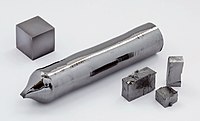
A Fluoride‐Free and Super‐Wetting Functionalized‐Material with pH‐Responsiveness for Controllable Separation of Multiphase Oil/Water Mixtures
Sign Up to like & getrecommendations! Published in 2020 at "Advanced Engineering Materials"
DOI: 10.1002/adem.202000983
Abstract: Nowadays, oily wastewater seriously endangers human health and living environment. Intelligent materials with switchable wettability gear up the broad application prospect in controllable oil/water separation and have received extensive attention. Herein, a simple and novel… read more here.
Keywords: oil water; separation; fluoride free; material ... See more keywords

Fluoride‐Free 2D Niobium Carbide MXenes as Stable and Biocompatible Nanoplatforms for Electrochemical Biosensors with Ultrahigh Sensitivity
Sign Up to like & getrecommendations! Published in 2020 at "Advanced Science"
DOI: 10.1002/advs.202001546
Abstract: Abstract Recently, 2D niobium carbide MXene has drawn vast attention due to its merits of large surface area, good metallic conductivity, and tunable band gap, making it desirable for various applications. However, the usage of… read more here.
Keywords: niobium carbide; stable biocompatible; fluoride free; mxene ... See more keywords

Photocatalytic immobilised TiO2 nanostructures via fluoride-free anodisation
Sign Up to like & getrecommendations! Published in 2020 at "Journal of environmental chemical engineering"
DOI: 10.1016/j.jece.2020.103798
Abstract: Abstract Current methods for anodising titanium to produce immobilised titanium dioxide (TiO2) photocatalysts require the use of hazardous fluoride electrolytes. A fluoride-free electrolyte anodisation method was developed, using bromide- and chloride-based electrolytes and ethylene glycol… read more here.
Keywords: immobilised tio2; anodisation; fluoride free; photocatalytic immobilised ... See more keywords

Fluoride-free Synthesis of Germanosilicate CIT-13 and Its Inverse Sigma Transformation To Form CIT-14
Sign Up to like & getrecommendations! Published in 2020 at "Chemistry of Materials"
DOI: 10.1021/acs.chemmater.9b05072
Abstract: Germanium-containing, extra-large pore molecular sieve CIT-13 is synthesized without the use of fluoride. After the removal of occluded organics, CIT-13 obtained from fluoride-free preparation shows significant differences from CIT-13 samples prepared in the presence of… read more here.
Keywords: cit; fluoride free; inverse sigma; sigma transformation ... See more keywords

A fluoride-free siliceous STW-type zeolite synthesized using a designed organic structure-directing agent.
Sign Up to like & getrecommendations! Published in 2023 at "Chemical communications"
DOI: 10.1039/d2cc05850b
Abstract: A pure silica STW zeolite is synthesized with no impurities under a wide range of synthesis conditions with and without fluoride by using easily available 1-methyl-1,5-diazabicyclo[4.3.0]non-5-ene (MDBN) as a template. MDBN having an appropriate size… read more here.
Keywords: zeolite synthesized; structure directing; fluoride free; free siliceous ... See more keywords

Fluoride-free synthesis of anodic TiO2 nanotube layers: a promising environmentally friendly method for efficient photocatalysts.
Sign Up to like & getrecommendations! Published in 2022 at "Nanoscale"
DOI: 10.1039/d2nr03379h
Abstract: TiO2 nanotube (TNT) layers are generally prepared in fluoride-based electrolytes via electrochemical anodization that relies on the field-assisted dissolution of Ti metal forming nanoporous/nanotubular structures. However, the usage of fluoride ions is considered hazardous to… read more here.
Keywords: synthesis anodic; fluoride free; environmentally friendly; tio2 nanotube ... See more keywords

There is no F in APC: Using physiological fluoride-free solutions for high throughput automated patch clamp experiments
Sign Up to like & getrecommendations! Published in 2022 at "Frontiers in Molecular Neuroscience"
DOI: 10.3389/fnmol.2022.982316
Abstract: Fluoride has been used in the internal recording solution for manual and automated patch clamp experiments for decades because it helps to improve the seal resistance and promotes longer lasting recordings. In manual patch clamp,… read more here.
Keywords: clamp experiments; fluoride free; automated patch; patch clamp ... See more keywords